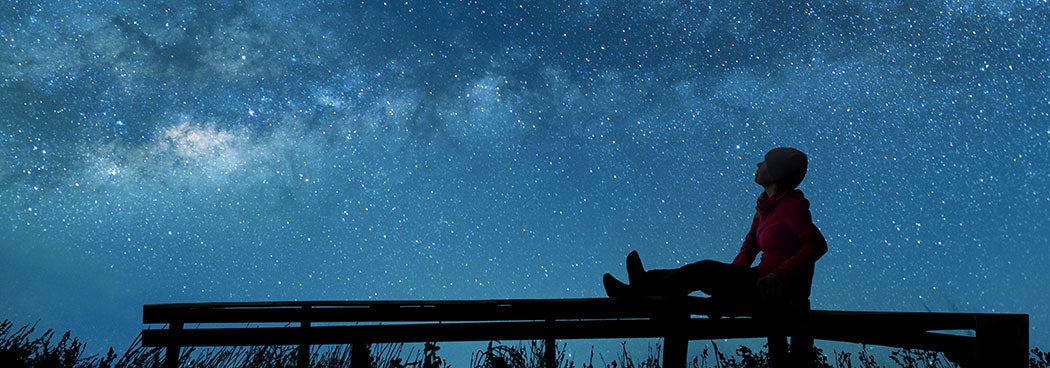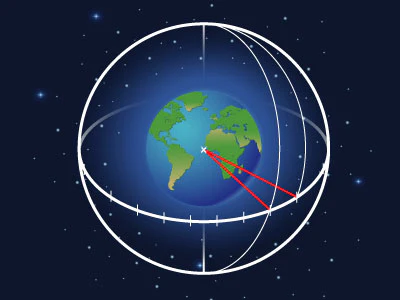
Observing stars: Essential tricks and tips
Observing stars and other objects in the night sky is a fascinating activity that can take your breath away. Because under good conditions, you can see about 3,000 - 5,000 stars. What many do not know: Professional equipment is not absolutely necessary because already, with the naked eye, there is a lot to discover. You just have to know what is important. In addition to essential criteria such as the weather and the time of day, the time of year and the location also play a decisive role. To get the best possible orientation, modern apps or an analog star map can also help.
Choose the right moment
Like the sun, the stars move from east to west. That means you cannot see every star all night and year. For example, the exceptionally bright star Sirius is only visible in regions such as Central Europe or Canada during the winter months, as it is above the horizon during the daytime in summer.
Depending on the season, different stars and objects can be observed. In addition, the season is also relevant in terms of darkness. Because in winter, the nights are particularly long and dark. Thus, winter nights offer perfect conditions for stargazing.
Not only the months but also the days play a significant role. This is mainly due to the moon. While on some nights, it illuminates the night sky in full glory and makes it difficult to see the stars, on other nights, it only shows itself as a small crescent or not at all. Therefore it's helpful to look at the phases of the moon in a lunar calendar in advance and choose a time around the new moon.
With regard to the appropriate time, it is important that you wait until the sun has disappeared deep below the horizon and no longer illuminates the sky. For this, it can be helpful to inform yourself in advance about sunset times. Or even the time of the sunrise if you are considering stargazing in the morning.
In addition to the above criteria, you should also keep an eye on the weather forecast and choose a cloudless night.
Find the optimal location
First, you should know which stars and objects you can basically see from your location because not every star can be observed worldwide. For example, due to its southern location, the very bright star Acrux cannot be seen from Central Europe. The very famous star Polaris, on the other hand, can be wonderfully observed from the northern hemisphere and does not show up south of the equator. This first estimation helps you to avoid looking for stars or objects that are in doubt not visible from your region.
To see as many stars and objects as possible, you should also go to a dark place with few artificial light sources, such as street lamps. Because due to this so-called light pollution, or light smog, your eyes are less sensitive, and you may not be able to perceive faint stars.
Rural regions away from big cities usually offer very good conditions. In addition, you can drive up to hills or mountains because the higher you are, the less haze can disturb your view of the night sky.
Going to a certified Dark Sky Park is also a good idea if you want to have especially good conditions. Here you can find the best-known Dark Sky Parks worldwide. These are regions and nature parks that offer optimal darkness. In addition, observatories can provide a beautiful view of the stars.

Take your time
For an unforgettable experience, you should plan enough time. Because not only can the search for the optimal place take a few minutes, but also your eyes need time to get used to the darkness. Only after 20-30 minutes in complete darkness will your eyes adapt to the environment. During this time, you should avoid bright light sources such as car headlights or your smartphone. This is the only way to guarantee that your eyes have adapted to the dark.
After some time, you will notice that more and more stars and nebulous objects in the night sky become visible to you.
Pack the right equipment
As described at the beginning, professional equipment, such as a telescope, is not necessary for a beautiful view of the stars. However, to have an unforgettable experience, you should still think about some things.
Because even in summer, the nights often get damp and cold, so we recommend you pack warm shoes, a jacket, and a hat. In addition, a thick blanket or warm tea can help.
Since you will probably spend some time in nature, having a chair, beanbag, or blanket to lie on is also nice. For hunger, snacks may not be missing. Depending on the region, you should also think of a bug spray.
As a light source, you should use a red-light flashlight. This provides sufficient light without irritating your eyes. You can already find affordable models on the Internet. If you don't want to buy a flashlight right away, you can stick red cellophane on a conventional flashlight.
Helpful additional tools
If you take the above tips into account, you are already well prepared for a wonderful experience under the stars. However, we would like to introduce you to three more helpful tools.
1. Our free App: Your Night Sky Guide
Our free app is like a virtual planetarium on your smartphone. It displays passing objects, such as satellites in real-time and guides you through the night sky by intuitively moving your phone. This way, you can easily discover certain objects in the night sky.
2. Analog star chart
If you prefer analog, we recommend a rotating star chart. You can use it to find constellations and other objects in the night sky. Please keep in mind to order a star chart that includes the latitude of your location (e.g. latitude zone 40°-50° for northern United States and part of Europe).
3. Book: Stargazing for Beginners - Explore the Wonders of the Night Sky
This comprehensive guide provides clear explanations and removes the mystery surrounding stargazing. It helps you identify various celestial objects and demonstrates their movements across the night sky throughout the year. By delving into the intricacies of the cosmos, it equips you with the knowledge and skills necessary to appreciate and engage in practical astronomy, starting from the fundamentals and progressing to more advanced techniques. You can order it here.
Read more interesting articles

How to read star data
The information about stars can be quite confusing. Read helpful and simple explanations of the most important terms around stars.

Stars: formation, colors and types
Read exciting information about the formation, the different colors, and the type of stars.

Planetarium App
Discover the night sky with our planetarium app!
Available for iOS and Android.


